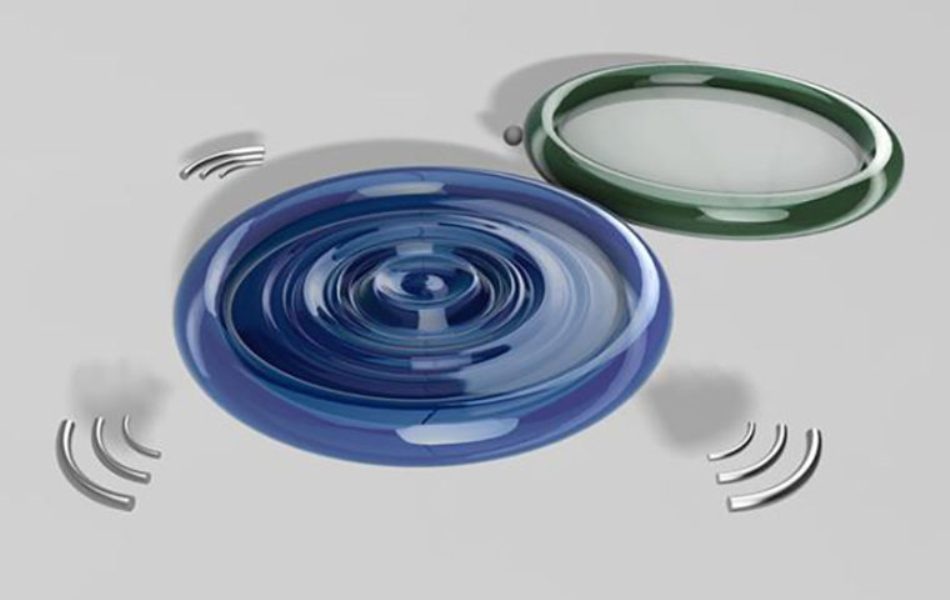Jul 27 2018
A group of international researchers headed by engineers from the Washington University in St. Louis has seen the light and currently has a lasing system with the ability to produce “good vibrations.”
 A phonon laser formed by coupled optical resonators. Mechanical vibrations in resonator (blue) could be enhanced when the frequency difference of two optical supermodes matches with the frequency mechanical vibrations. (Image credit: Micro/Nano Photonics Lab)
A phonon laser formed by coupled optical resonators. Mechanical vibrations in resonator (blue) could be enhanced when the frequency difference of two optical supermodes matches with the frequency mechanical vibrations. (Image credit: Micro/Nano Photonics Lab)
The researchers designed and created a lasing system already proficient in producing tiny packets of light known as photons into a tunable system that also produces small bits of mechanical energy known as phonons - the energy products of oscillation, or vibration.
By achieving this, they are the first research team to widen the so-called laser linewidth in the phonon laser and guide it through a physical system called the “exceptional point.”
Linewidth is an important component of lasing, revealing the physical integrity of the lasing signal and also the measure of generally unwanted noise in the laser.
The study, which involved collaborators from China, Austria, Japan, and Michigan, has been reported in the July 9, 2018, issue of Nature Photonics.
“We’ve shown that you can use a light field to trigger the mechanical movement that will generate an acoustic (sound) wave,” stated Lan Yang, the Edwin H. & Florence G. Skinner Professor of Electrical & Systems Engineering in the School of Engineering & Applied Science.
“Think of phonon lasing as a counterpart to traditional optic, or photon lasing, with exciting applications in medical surgery, materials science and communications. We have demonstrated a controllable phonon laser that can be tuned for threshold and linewidth, among other potential parameters.”
“Our study for the first time provides direct evidence that exceptional point-enhanced optical noises can be transferred directly to mechanical noises,” stated Yang.
Yang’s laser, an acronym for light amplification by stimulated emission of radiation, belongs to a category known as whispering gallery mode resonators (WGM), which function similar to the famous whispering gallery in St. Paul’s Cathedral in London, where a person located on one side of the dome can hear a message spoken to the wall by another person on the other side. In contrast to the dome, which has sweet spots or resonances in the audible range, the sensor resonates at light frequencies and currently at mechanical or vibrational frequencies.
Consider the exceptional point as a complex, super-energy mode, where often counterintuitive and unpredictable phenomena take place. Even before, the exceptional point has contributed to various counterintuitive activities and results in recent physics studies—with expectations of more discoveries. In this international research project, the physical system was described using mathematical tools: When two complex eigenvalues and their eigenvectors coalesced, or became one and the same, an exceptional point emerged in a physical field.
“We use the phonon laser system rather than the photon laser to demonstrate our main results because it is easier to check the linewidth of the phonon laser compared with that of the photon laser,” she stated.
Imagine the two WGM microresonators to be positioned close to each other in a field with two photon detectors linked by a wave guide bringing light in and out of the system. Let these two “super modes” be called Resonator 1 and Resonator 2.
“In the first resonator, which supports photons and produces phonons, we know when the light field is strong enough the radiation will trigger the mechanical oscillation related to the acoustic wave vibration,” stated Yang. “We calibrated the acoustic wave frequency at 10 megahertz. Then we adjusted the gap between the two resonators to look at the transmission spectrum of the coupled resonators. When we changed the gap, we found that we could tune the spectral distance. We tuned it from 100 megahertz, to 80 to 50 depending on the physical gap between the resonators. If you tune the gap nicely to match the spectral distance between the two to the frequency of the mechanical vibration, then you have resonance.”
Resonance is the phenomenon in which an external force from a system makes another system to oscillate at specific frequencies.
The two light fields have two distinctive energy levels and frequencies. The mechanical frequency of 10 MHz is in agreement with the energy difference between the two super modes. Although both resonators support photons, only one of them produces phonons.
In future studies, Yang plans to investigate in depth the energy exchange between the two super modes in phonon lasing and continue to look for surprises at the exceptional point.
Ironically, she calls phonon lasing’s future “very bright.”